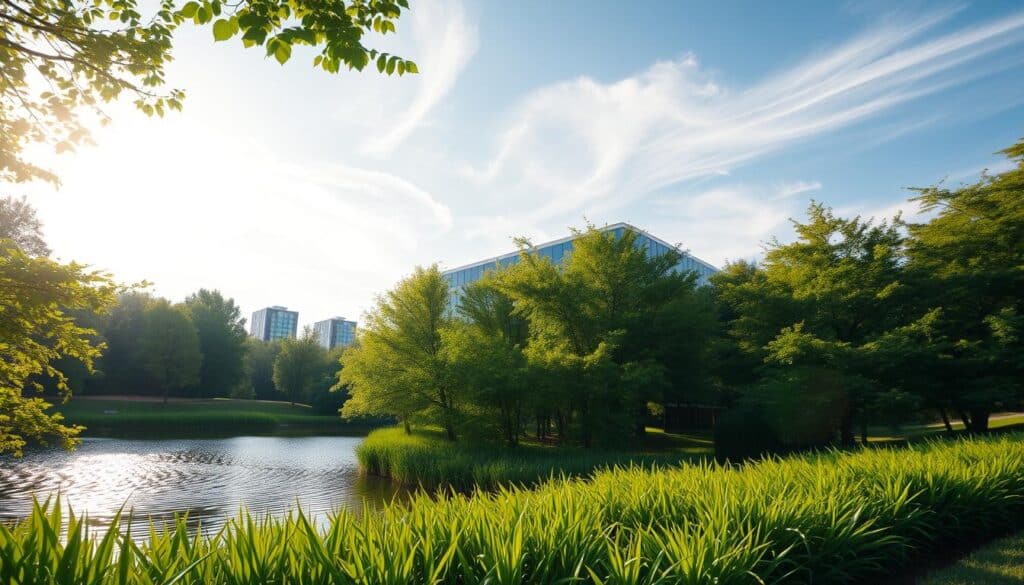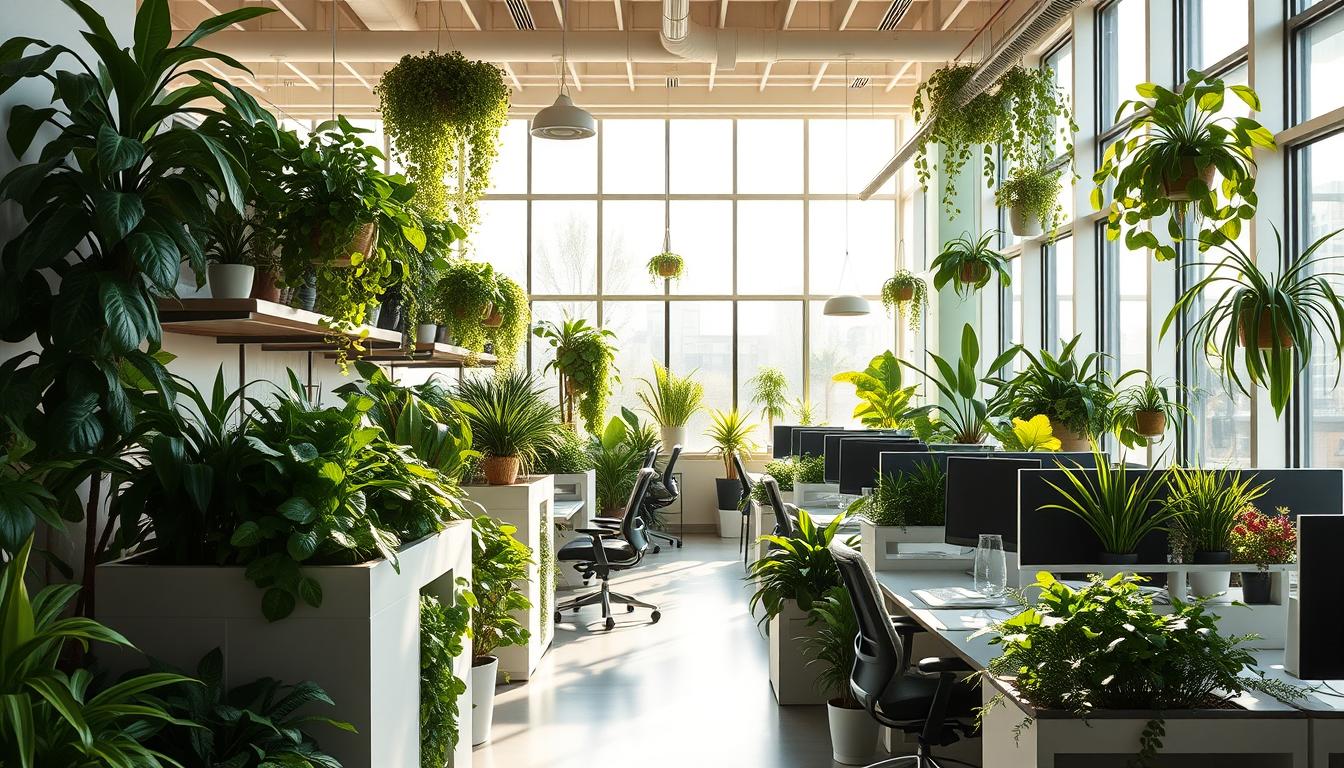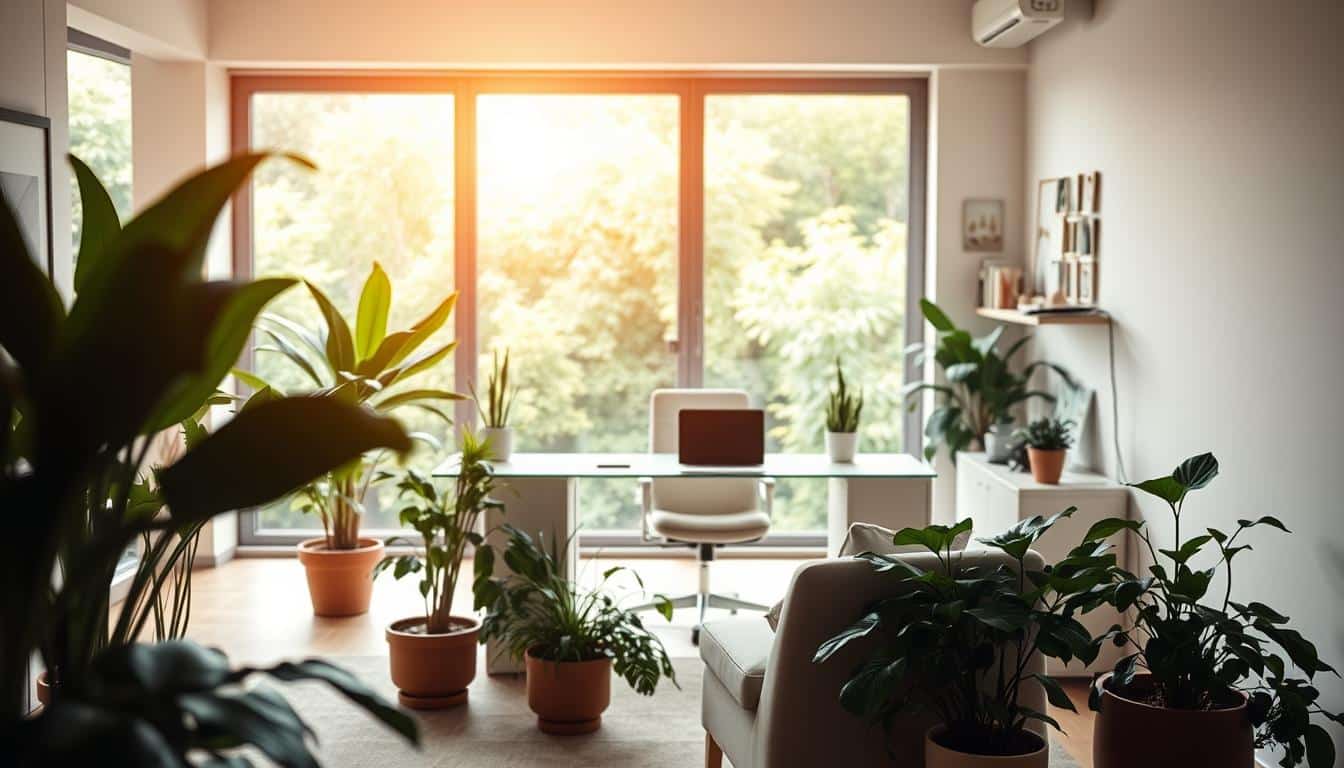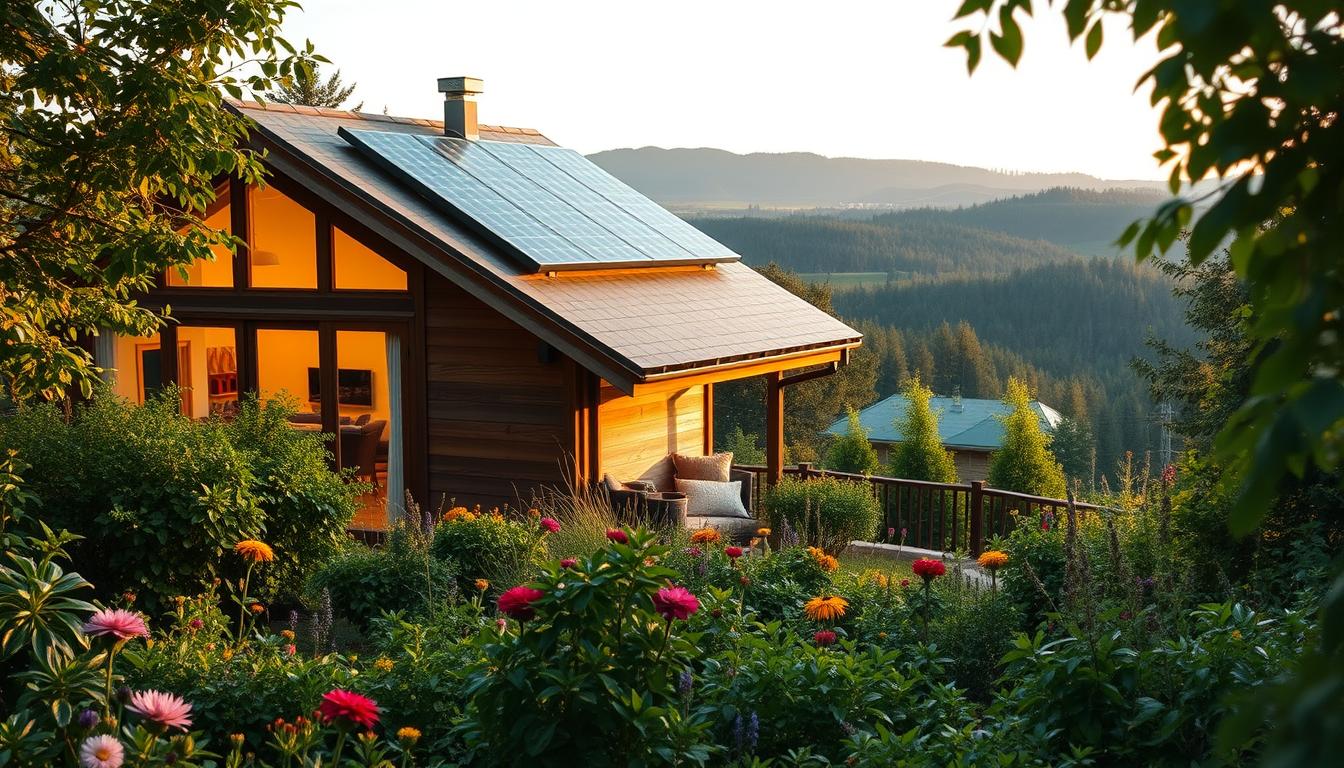In today’s fast-paced work world, making offices better for everyone’s performance and happiness is key. Adding natural air buffer zones is a new trend. These areas use nature to boost air quality, cut down noise, and make workplaces healthier.
They help people stay healthy and work better. This piece will explore how these zones change offices for the better.
The Importance of Natural Air Buffer Zones in Offices
Natural air buffer zones are key for a good workplace design. They act as barriers to bring fresh air to employees. Adding nature into offices cuts down health risks from bad air. These areas also lower loud noises, making work more peaceful.
Studies show the health perks of natural air buffer zones at work. Better air means staff take fewer sick days and enjoy their jobs more. This boost in happiness makes them more productive and improves team spirit.

Understanding Air Quality and Workplace Productivity
Poor air quality can really slow down work performance. This is because bad air can harm our brains and how we feel. Studies show that when the air is dirty, workers get more tired, can’t focus well, and miss more days of work.
When offices make their air cleaner, everyone works better. Adding areas with fresh air helps make the air better all around. Workers feel less stressed and can pay attention more. Having a clean place to work makes people want to do more and do it well.
Companies should think of clean air as key for doing well. A clean working space means workers are sharper and can do their tasks better. So, adding fresh air areas can make everyone happier and do their jobs better.
What are Natural Air Buffer Zones?
Natural air buffer zones are key to making office spaces better. They help make the air healthier. By controlling airflow, they add to workers’ comfort and help them do better.
Definition and Purpose
These zones include plants, water elements, and barriers. They do more than look good; they clean the air and make work more enjoyable. Adding these elements improves health and boosts morale at work.
Types of Natural Air Buffer Zones
Offices can use different kinds of natural air buffer zones. These include:
- Green Walls: Vertical gardens that clean the air and look beautiful.
- Water Features: Fountains or ponds that relax people and clean the air.
- Tree Canopies: Areas with trees that clean the air and cool the environment.
- Landscaped Gardens: Well-designed outdoor spaces that improve air quality and look nice.
Benefits of Implementing Natural Air Buffer Zones in Offices
Adding natural air buffer zones to offices is hugely beneficial. They make for a nicer work environment and boost employee health. This leads to happier, more efficient teams.
Improved Employee Health and Well-being
These zones make workplaces healthier by cutting down on harmful indoor air. This helps prevent lung issues and stress-related problems. Being near plants helps people feel more at peace. This makes offices better places to work.
Enhanced Focus and Productivity
Natural air buffer zones improve health and focus, making workers more productive. Being close to nature gives them more energy and helps them concentrate better. This means they do their jobs better, showing why these zones are key in office design.
How to Design Effective Natural Air Buffer Zones in Office Spaces
To create natural air buffer zones in office spaces, focus on where furniture goes and add plants. This setup makes offices more productive and comfy. Arrange furniture smartly and use plants to boost this.
Considerations for Furniture Placement
Putting furniture in the right spots is key for air buffer zones. Think about these things:
- Place desks and work areas to help air move well.
- Make sure people can walk around easily, making movement smooth.
- Choose furniture you can move and change as needed.
Utilizing Landscaping Elements
Adding plants and nature touches makes offices look and work better. Try these ideas:
- Use indoor plants to clean the air and relax the mood.
- Put plants near where people work to block noise and distractions.
- Add water features or natural stuff to make the space calm.
The Role of Plants and Greenery in Air Quality
Plants are key in making air quality better at work. They absorb bad pollutants and give out oxygen because they photosynthesize. This action improves air quality, helping people work better.
Research shows that plants can make us feel happier and less stressed. Having plants around the office does more than clean the air. It also helps the mental health of the people working, making a nicer workplace.
Plants are not just pretty. They help reduce indoor air pollutants like formaldehyde and benzene. By placing plants around the office wisely, companies can make the air cleaner. This also makes employees happier.
Adding greenery to the office does more than look good. It creates a healthy and productive environment. Plants play a big role in modern office design by cleaning the air and making employees’ experiences better.
Impact of Natural Air Buffer Zones on Noise Reduction
Noise pollution can lower how well people work and focus in offices. Natural air buffer zones help a lot here. They use plants and soil to soak up and scatter noise, making a quieter workspace.
Adding plants to office spaces makes them look good and sound better too. Plants help block noise, especially the sort that bugs us most. This makes it easier for everyone to concentrate and get things done.
Offices with natural air buffer zones are more peaceful places to work. This calm helps people do better at their jobs. They’re less bothered by loud sounds from outside.
Strategies for Integrating Natural Air Buffer Zones into Office Layouts
For a successful buffer zone integration, designers and employees must work together. This teamwork gives employees a feeling of ownership over the new design, leading to better acceptance. Analyzing how employees move and use their workspace helps identify the best spots for air buffer zones.
Adaptive design is key in making this work. These designs allow spaces to switch between group and solo work settings when needed. Adding plants and living walls makes it easy to change a room’s feel without much effort.
Think about these things when planning office layouts that include natural air buffer zones:
- Conduct surveys to understand employee preferences for space usage.
- Use analytics to monitor the flow of people and identify congested areas.
- Allocate sufficient space for greenery without compromising available workstations.
- Implement movable partitions that can help in shaping open or secluded environments.
Analyzing Local Regulations for Natural Air Buffer Zones in Offices
Getting to know local rules on air quality is key to making natural air buffer zones in offices. These rules help manage air pollution and keep a safe space for workers and neighbors. Knowing about buffer zone zoning helps pick office spots away from harmful industrial smoke.
Following local air quality laws is a must. It’s all about keeping workers healthy and making air buffer zones work well. Checking your area’s laws helps in planning and setting up these zones right. Zoning right means more green spaces and plants that clean the air.
Working with local authorities ensures companies follow the rules and might get them perks for using natural ways to boost air quality. Designing buffer zones by the book raises a company’s good standing and shows it cares about being green.
Creative Solutions to Maximize Space with Natural Air Buffer Zones
Creative office design is key in making the most of office space. Using natural air buffer zones cleverly brings together function and beauty. Think about adding vertical gardens. They make the air cleaner and use vertical space well, saving floor space.
Modular furniture is another smart choice. It can change shape or layout to fit various activities and team sizes. It helps keep the office flexible. Also, combining storage and seating is a smart move. It keeps things tidy and looks good too.
These ideas show how to use space well and include natural air buffer zones. With these innovative designs, offices become more appealing and productive. They don’t lose out on comfort and usefulness either.
Case Studies: Successful Implementations of Natural Air Buffer Zones
Natural air buffer zones have helped offices greatly. They’ve made workers healthier and offices better places to be. Here are two examples where these ideas really made a difference, especially in tech office designs.
Example 1: Tech Company Office Revamp
A leading tech company revamped their office with natural air buffers. They added living walls and green spaces all over. This made employee health and happiness much better.
Workers felt more awake and less stressed. They liked the cleaner air and quieter spaces. This made them more productive at work.
Example 2: Corporate Headquarters Transformation
A corporate headquarters got a big makeover with buffer zones. The design wasn’t just nice to look at; it was smart, too. It had indoor plants and open spaces for teamwork.
This made a creative and healthy work environment. The changes showed how natural air buffers can improve work life. It also showed good design ideas for tech offices.
Measuring the Effectiveness of Natural Air Buffer Zones
To measure how well natural air buffer zones work, it’s important to look at a lot of things. Companies should check the air quality index. This index shows how clean or polluted the air is inside. Using high-tech sensors to test the air is key. They give info on harmful substances, moisture, and temperature changes.
Looking at how well employees work is also a way to see the benefits of these zones. Asking employees how they feel and if they’re happy can tell us a lot. It helps understand the true value of having clean air at work.
Having a good plan to measure success is crucial. It helps find what’s working and what needs to get better. Regular checks make sure offices are great for work and health. This creates a perfect place to work.
Conclusion
Having natural air buffer zones is key in making office spaces better. These areas help make workplaces healthier and boost how happy and productive employees are. When people work in a place they feel good about, close to nature, they tend to do better at their jobs.
As work environments evolve, it’s crucial for companies to embrace green design. Natural air buffer zones do more than look nice. They’re essential for cleaner air and less noise, making the office a more pleasant place to be.
So, natural air buffer zones aren’t just a fancy office trend. They’re a significant move towards making workspaces sustainable and pleasant. As businesses keep adding these features, they won’t just have healthier buildings. They will also have workers who are more involved and happy.



